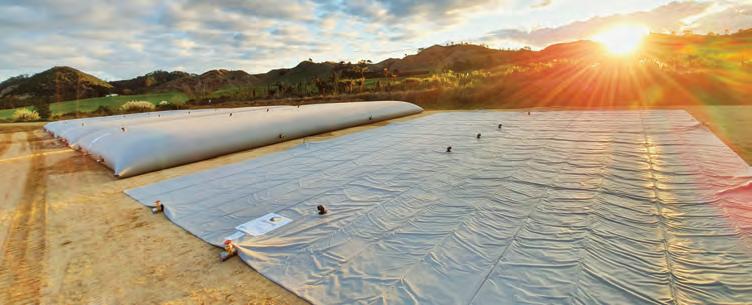
5 minute read
No bending to fire’s will
from STW Sep 2020
by Prime Group
Flexibladder fetches firefighting facilities for site
FOR MORE THAN 60 YEARS, LABARONNE CITAF HAS DESIGNED AND BUILT FLEXIBLE BLADDER TANKS FOR LIQUID STORAGE AND TRANSPORTATION. SAFE TO WORK SPEAKS WITH FLEXIBLADDER ABOUT ITS FIREFIGHTING APPLICATIONS FOR MINE SITES.
Flexibladder was dreamed up by Andre Labaronne in 1958 when he noticed productivity gains could be made in transport and storage using his invention over conventional methods.
From there, the idea was formed to develop a flexible bladder that could be folded up and stored for transport, then rolled out and used on the return trip so trucks transporting goods in one direction could utilise the empty truck for liquid on the return journey. No more wasting a trip.
Fast forward 62 years and Flexibladder is used across a range of industries, including mining; agriculture and viticulture for liquid fertiliser, water, potable water, leachate, fuel and dairy effluent storage irrigation and in the case of the Oaky Creek coal mine in Queensland, firefighting.
At remote mine sites like Oaky Creek, it can be difficult to get firefighting equipment onto location at the time of an emergency and often by the time an emergency crew with a firefighting appliance arrives, it is too late.
Flexibladder has installed a 300,000-litre tank at the Central Queensland site, giving Oaky Creek water at the location as a short-term
solution while long-term permanent infrastructure is installed.
Further, Flexibladder can also integrate long-term fire safety plans, as its 10-year warranty and 20-year plus life expectancy against heat and sun means it has the durability to reliably perform over many years. Australian director David Bennett says Flexibladder tanks combine strength and flexibility, making them tough enough to withstand harsh mining conditions, while being flexible enough to be used across a range of applications.
“Flexibadder tanks are extremely
Flexibladder’s storage tanks are durable enough to withstand Australia’s hot and arid conditions.
Flexibladder Australian director David Bennett.

tough and very strong. Flexibility is our strength,” Bennett tells Safe to Work.
To install the Oaky Creek tank, the civil engineering team first built a pad area in the chosen location and levelled it to ensure the tank was on a level surface as per the manufacturers’ pad preparation requirements.
Another advantage of Flexibladder’s tanks is they can be installed within hours of arriving at a site and the mine can start using them straight away.
In the summer of 2019-20, Australia saw first-hand how important it is to have a solid supply of water and firefighting solutions, experiencing bushfire equal to some of the worst in our history.
With the 300,000-litre tank, Oaky Creek can now use it to store water for firefighting purposes, giving the mine site the capability to start fighting fires before emergency services arrive.
With minutes often being the difference between substantial and devastating fire damage, Flexibladder tanks are a fantastic solution for operations located at a distance from emergency services.
Once emergency services arrive on site, the Flexibladder tanks also give them a large on-site supply of water, meaning trucks do not have to make as many trips to and from the site when battling a larger blaze like a bushfire.
“Flexibladder tanks allow you to pump water and start fighting the fire direct from the tank as a standalone mass storage resource connected directly to a firefighting system if town water is not available or has been cut off due to infrastructure damage,” Bennett says.
“The other aspect where our tanks are helpful is actually delivering water to the fire. It is all well and good to have the truck there doing the firefighting, but when it runs out of water, you need to send the truck away for more water.
“While waiting for the main tanker to arrive there’s all this extra downtime, which, if you have a Flexibladder tank strategically located, the main tanker can unload large volumes then head off to get another load while the smaller firefighting appliances come and refill from the continuous flow of the bladder.”
With its products being distributed to many hot and dry destinations, Flexibladder mainly focusses on manufacturing larger sized tanks – tanks that can store anything from 1000 litres for the smaller models, right up to the giant two million litre or 2000 cubic metre models, which only Flexibladder has the technology to manufacture.
While Flexibladder’s tanks are designed in France, they are created to withstand the harshest conditions in the world, and Flexibladder manufactures the most durable flexible tank storage of all solutions in Australia.
“Flexibladder tanks are manufactured at our state-of-the-art facility in France using the highest quality fabrics that are treated for high ultra-violet (UV) factor and heat resistance,” Bennett explains.
“Our tanks are being used by operations in some of the worst deserts in the world, including the Desert of Oman, which is up there with the worst conditions in the world.
“Australia with its remote, hot destinations like the Pilbara is up there, so our Australian customers are guaranteed to be fitted with a solution that will last in their harsh environment.”
In preparation for the 2020-21 summer, Flexibladder is working with consultants designing Flexibladder firefighting infrastructure across airports and air bases, as well as farms, other
Flexibladder has installed a 300,000-litre tank at the Oaky Down mine in Queensland.

horticultural operations, and mine sites like Oaky Creek.
With the huge storage capacity and ease and speed of installation of Flexibladder tanks, they are bringing the ease of on-site firefighting to mines and other rural operations Australia wide.
“When it comes to fire safety, it’s all about management,” Bennett says. “It’s about preparing and planning for the worst case and hoping that you never have to use your Flexibladder tank, but if you do need it, it’s there. It’s better being a year too early than a day too late with fire management.”










